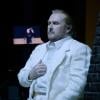
Since her tenure as San Francisco Opera’s music director began in 2021, Eun Sun Kim has been a vital force for good for the company. From Verdi to Wagner, from Mozart to Beethoven to John Adams, her preparation and conducting have consistently articulated, animated, and heightened the music drama onstage, fusing singers, orchestra, and chorus in graceful and compelling ways. In affirmation of her artistry, Kim’s contract was recently extended five years, through 2031.
On Saturday, Oct. 26, the 44-year-old conductor assumed a new role, taking center stage to lead the Opera Orchestra, Chorus, and four soloists in a single performance of Beethoven’s Symphony No. 9. The concert, which marked the 200th anniversary of this classical masterpiece, was sold out. The War Memorial Opera House stage looked handsomely transformed, fitted with a new acoustic shell of golden wood panels. Curiosity and anticipation were high for Kim’s first-ever performance of Beethoven’s Ninth.

The results, unfortunately, fell considerably short of expectations. Marked by uncertain phrasing and balance, spotty cohesion, and a prevailing lack of the dramatic tension and release that this great and very familiar work demands, this was not a performance to savor or remember.
The problems began early, as the falling two-note figure in the symphony’s opening bars whispered without raising an air of premonition. The movement progressed, with some nicely poised woodwind passages along the way, but didn’t build to a decisive finish, not even in a dramatically stretched moment of rubato near the end.
After an emphatic start from the timpani and strings, the scherzo lost focus. Even as Kim dialed the dynamics up and down, the movement’s momentum and sense of purpose went missing. The horns muttered in the background. Phrasing was often murky.

The woodwinds, who stood out all evening, did some fetchingly lyrical work in the Adagio. The strings, too, exhibited warmth. But when the cellos and basses broke into their assertive demand that launches the fury, merriment, and exultation of the symphony’s concluding movement, their crucial lines lacked urgency and bite. It was a characteristic shortcoming.
As for the vocal forces, positioned on risers behind the orchestra, nothing came up short. Chorus and soloists alike sang with intensity and blazing conviction. Soprano Jennifer Holloway, mezzo-soprano Annika Schlicht, tenor Russell Thomas, and bass Kwangchul Youn sounded especially spirited, even youthfully exuberant. Beethoven’s fervent setting of German poet Friedrich Schiller’s “Ode to Joy” rang out from every voice.
Kim exuded a lively presence throughout the 70-minute performance, with a big, clear beat, expansive cueing gestures, and a switching ponytail. While her non-operatic work is little known here, aside from a 2022 concert with the National Brass Ensemble at Davies Symphony Hall, Kim has led numerous orchestral performances elsewhere. She made her New York Philharmonic debut in February and is booked for concerts with the Los Angeles Philharmonic and Boston Symphony Orchestra, among others, next year.

Saturday’s performance of Beethoven’s Ninth was a different matter, with certain intrinsic perils. Unlike symphony orchestras that have the piece in their bones, the musicians of the Opera Orchestra were outside their comfort zone here. Perhaps, given their other absorbing commitments — like the production of Wagner’s monumental Tristan and Isolde currently underway (through Nov. 5) — rehearsal time for the Beethoven was constrained. It should also be noted that the orchestra musicians are currently amid contract negotiations with management after reaching a short-term agreement in September.
Whatever the reasons, the evening felt more like an experiment than something polished and ready for prime time. Admirable and essential as it is for performing artists to take risks, this concert may have been more rewarding for the players than those listening and inevitably comparing what they heard to past performances of Beethoven’s Ninth embedded in memory.
This story was first published in Datebook in partnership with the San Francisco Chronicle.




